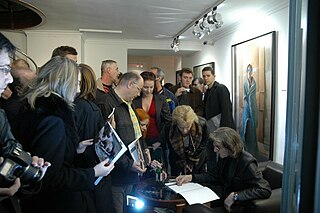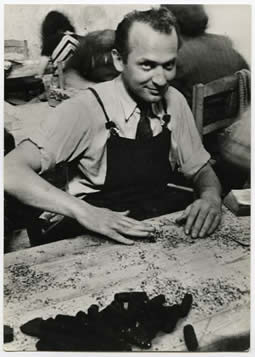Biography
Early childhood
As a child he was interested in art and drew frequently. His father was an air force pilot and his mother was a housewife. His mother eventually showed his work to the director of the Ecole des Beaux-arts in Moscow and he was admitted. The best drawings were shown in a window that gave onto the street. The first time one of his drawings was shown, he proudly asked his mother to come with him to see. Someone had broken the window and stolen his drawing. “This was my first artistic success” said Victor Koulbak. [1]
At school with the Masters
At the end of his secondary school studies and his apprenticeship with the Beaux-arts, Koulbak realized there was a gap in his schooling. He decided to find a “Master” and stopped looking once he found a well-known artist. From the first day, however, the student argued with his teacher and left the workshop immediately: the master in question imposed his own style, his own aesthetic principles and personal vision, and brought nothing new from the technical point of view. The young artist then made the most important decision of his life: to discover by himself the principles and techniques of the old "Masters". At first he was impressed by Pieter Brueghel the Elder, Paul Cézanne and Vincent van Gogh, but then he soon turned to Leonardo da Vinci, Michelangelo, Albrecht Dürer, Jan van Eyck, Hans Memling, and others of great skill. [2]
Soviet censorship
Refusing the dictates of official art: “Social Realism”, Koulbak put himself on the side of non-conformist painters, thus depriving him of lucrative orders. So, in order to survive, he was forced to work on illustrations for books and magazines. However, he continued to paint clandestinely, for himself and for a small group of friends, but everything became more and more difficult: art supplies were reserved for members of the Soviet Artists Union, and others had difficulty in procuring these necessities for their work. For example, in summer there would be no green available, and in winter there would be no white. To become a member of the Union, you had first had to have participated in two official exhibitions. [3] The selection committees, who protected soviet realism, were exclusively made up of Party members totally faithful to the regime. This regime became slightly more flexible during the 1970s. Exhibitions were organized with debates and held in non-public spaces, such as the Institute of Nuclear Physics of the Academy of Sciences, but were only accessible to those holding a laissez-passer issued by the Party and the KGB. Koulbak was able under these conditions to hold two exhibitions, which were, however, closed after only two hours.
Stendhal's Syndrome
In 1975 Koulbak left the USSR. He then went to Vienna and stayed for six months, visiting all the wonderful museums of that city. The contemplation of Brueghel’s paintings put him into a trance, so much so that he was awoken by one of the guards at the closing of the museum. He had been in front of Brueghel’s work from 11.00 in the morning until the closing of the museum in the evening, victim of Stendhal syndrome, described by Stendhal in 1878 in his book Rome, Naples and Florence. [4]
Sweden, France and Malta
Before leaving the USSR, Koulbak had sent several of his works to Sweden. He was invited by a gallery in Stockholm, and within one year had four exhibitions of his own in Helsingborg, Stockholm, Malmö, and Oslo. In 1976 he moved to Paris. Since then 25 personal exhibitions and numerous collective exhibitions have been dedicated to his art in France, Italy, Japan, Canada, Belgium, the United States of America, the United Kingdom, Germany, and Malta. Koulbak has been a resident of Malta since the year 2000.
Body of Work
Periods
During his "exploratory" period in Moscow from 1965 to 1975, Koulbak experimented with all types, techniques and styles.
« Surréalist » Stockholm then Paris, from 1975 to the 1980s
In Contemplation (1977).
Metamorphoses (1977).
Traveller (1977).
Meditation (1978).
« Thematic » Paris from 1980 to 1990.
During his "Master’s" period in Paris, followed by Malta in the 1990s, Koulbak’s main body of work has been executed in silver point.
Artistic Vision
"The Renaissance, says Victor Koulbak, represented the art at its summit. The artist, in his representation of man, aspired to the divine. And this could not be done without mastery. Neither before nor after this period did the artist achieve such heights. The history of art of following periods is just a derivation. God was at first replaced by man, and then by the painter himself as the individual placed in all his triviality at the centre of the universe. We have gone from adoration to exhibitionism. How did we get there? Art education as a whole needs to be re-evaluated. We give a brush to a student and tell him “express yourself” but would we ever think to suggest such a thing to a student of the piano? Why should it seem absurd for the piano and not for the arts? No, in order to make a child a real artist, he needs first to learn to distinguish the beautiful from the ugly and to master his tools, to teach him techniques in order to enable him to transform his weaknesses into qualities. And to achieve this, many years of hard and difficult work are required. If it is not done today, the future of our world seems to me to be very dark. By refusing beauty, we refuse civilization. I don’t know if beauty can save the world, but without beauty, the world will not survive."

Robert C. Morgan is an American art critic, art historian, curator, poet, and artist.

Louis Marcoussis, formerly Ludwik Kazimierz Wladyslaw Markus or Ludwig Casimir Ladislas Markus, was a Polish-French avant-garde painter active primarily in Paris. Markus studied law in Warsaw before attending the Kraków Academy of Fine Arts, and later moved to Paris to study under Jules Lefebvre at the Académie Julian. His work was first featured in a major exhibition at the Salon d'Automne in 1905. In Paris, he became acquainted with prominent artists of the School of Paris and writers in the cafes of Montmartre and Montparnasse.

Maxime-Pierre Jules Dethomas was a French painter, draughtsman, printmaker, illustrator, and was among the best known theater-set and costume designers of his era. As an artist, Dethomas was highly regarded by his contemporaries and exhibited widely, both within France and abroad. He was a regular contributor to the Impressionistes et Symbolistes, and a founding committee member of the Salon d'Automne. In 1912, he was awarded the Chevalier de la Légion d'honneur for his contributions to French art.
Mario Prassinos was a French modernist painter, printmaker, illustrator, stage designer, and writer of Greek-Italian descent.

Léopold Frédéric Léopoldowitsch Survage was a Russian-French painter of Finnish origin. Trained in Moscow, he identified with the Russian avant-garde before moving to Paris, where he shared a studio with Amedeo Modigliani and experimented with abstract movies. He also gained commissions for Serge Diaghilev's Ballets Russes.

Annette Messager is a French visual artist. She is known for championing the techniques and materials of outsider art. In 2005, she won the Golden Lion Award at the Venice Biennale for her artwork at the French Pavilion. In 2016, she won the prestigious Praemium Imperiale International Arts Award. She lives and works in Malakoff, France.

Irène Hamoir was a Belgian novelist and poet, the leading female member of the Belgian surrealist movement. Her poetry was published under the pen name Irine, and she appeared as Lorrie in the writings of her husband, Louis Scutenaire, and the works of René Magritte.

Jean Rustin was a French painter and prominent figurative artist.
Fernand Toupin was a Québécois abstract painter best known as a first-generation member of the avant-garde movement known as Les Plasticiens. Like other members of the group, his shaped paintings drew upon the tradition of geometric abstraction, and he cited Mondrian as a forerunner. In 1959, Toupin began working with a more lyrical, though abstract, way of painting. The last decade of his career saw his return to geometric abstraction. Like Jean-Paul Mousseau, Toupin created works which lay outside the standard boundaries of art such as his stage sets for ballets.

István Sándorfi was a Hungarian hyperrealist painter.
Yolande Ardissone is a French painter. Born in Bueil (Normandy), she studied at the Beaux-Arts and at the Académie de la Grande Chaumière in Paris.

Grace Renzi, married name Grace Kantuser, was an American painter.
Aref El Rayess was a Lebanese painter and sculptor.

Joseph Csaky was a Hungarian avant-garde artist, sculptor, and graphic artist, best known for his early participation in the Cubist movement as a sculptor. Csaky was one of the first sculptors in Paris to apply the principles of pictorial Cubism to his art. A pioneer of modern sculpture, Csaky is among the most important sculptors of the early 20th century. He was an active member of the Section d'Or group between 1911 and 1914, and closely associated with Crystal Cubism, Purism, De Stijl, Abstract art, and Art Deco throughout the 1920s and 1930s.

Léon Zack, also known as Lev Vasilyevich Zak, was a Russian-born French figurative and later abstract painter and sculptor. He has been described as a School of Paris painter.

Alain Kirili was a French-American sculptor. He was recognized for his post-minimalist abstract sculptures in forged iron and his large-scale public sculptures. His work has been the subject of numerous gallery and museum exhibitions in United States and Europe, and has received considerable critical interest from art historians, such as Thierry Dufrêne, Robert C. Morgan, Robert Rosenblum, and Kirk Varnedoe. Kirili lived and worked in Paris and New York.
Barry X Ball is an American sculptor who lives and works in New York City.

Jacques Hérold was a prominent surrealist painter born in Piatra Neamț, Romania.
Nicolas Bokov was a Russian writer, who emigrated to France in 1975.
Lilya Pavlovic Dear is born on 30 May 1947 1 in Topola-Oplenac, Serbia (ex-Yugoslavia). She is a Franco-American artist. Lilya Pavlovic Dear is a painter, print-maker, photographer and video artist. She has more than 200 group shows and 60 solo shows.




























